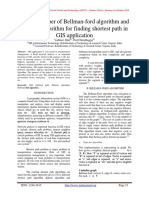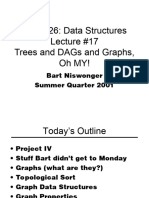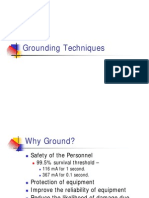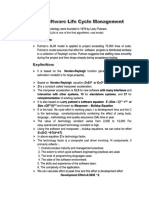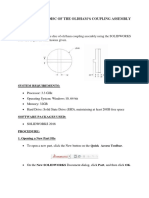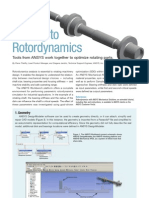18: Graph Data Structures: Software Development 2 Bell College
18: Graph Data Structures: Software Development 2 Bell College
Uploaded by
PrabhuCopyright:
Available Formats
18: Graph Data Structures: Software Development 2 Bell College
18: Graph Data Structures: Software Development 2 Bell College
Uploaded by
PrabhuOriginal Title
Copyright
Available Formats
Share this document
Did you find this document useful?
Is this content inappropriate?
Copyright:
Available Formats
18: Graph Data Structures: Software Development 2 Bell College
18: Graph Data Structures: Software Development 2 Bell College
Uploaded by
PrabhuCopyright:
Available Formats
Software Development 2 Bell College
18: GRAPH DATA STRUCTURES
Introduction ..................................................................................................................... 1
Describing graphs........................................................................................................... 2
Directed Graphs .............................................................................................................. 3
Traversing a graph.......................................................................................................... 4
EXERCISE: Traversal...................................................................................................... 8
Implementing a Graph .................................................................................................... 9
EXERCISE: Looking at a Graph ................................................................................... 12
EXERICISE: Implementing Traversal .......................................................................... 14
Networks ........................................................................................................................ 16
EXERCISE: Using Dykstra’s Algorithm....................................................................... 23
Introduction
We looked previously at the binary tree data structure, which provides a useful way of
storing data for efficient searching. In a binary tree, each node can have up to two child
nodes. More general tree structures can be created in which different numbers of child
nodes are allowed for each node.
All tree structures are hierarchical. This means that each node can only have one
parent node. Trees can be used to store data which has a definite hierarchy; for
example a family tree or a computer file system.
Some data need to have connections between items which do not fit into a hierarchy
like this. Graph data structures can be useful in these situations. A graph consists of a
number of data items, each of which is called a vertex. Any vertex may be connected to
any other, and these connections are called edges.
The following figure shows a graph in which the vertices are the names of cities in North
America. The edges could represent flights between these cities, or possibly Wide Area
Network links between them.
Edmonton
Anchorage Billings
Grand Rapids
Corvallis Denver
Flagstaff Houston
18. GRAPH Data Structures page 1
Software Development 2 Bell College
Describing graphs
The graph in the figure above is known as an undirected graph.
An undirected graph is complete if it has as many edges as possible – in other words, if
every vertex is joined to every other vertex. The graph in the figure is not complete. For a
complete graph with n vertices, the number of edges is n(n – 1)/2. A graph with 6 vertices
needs 15 edges to be complete.
Two vertices in a graph are adjacent if the form an edge. For example, Anchorage and
Corvallis are adjacent, while Anchorage and Denver are not. Adjacent vertices are called
neighbours.
A path is a sequence of vertices in which each successive pair is an edge. For example:
Anchorage-Billings-Denver-Edmonton-Anchorage
A cycle is a path in which the first and last vertices are the same and there are no
repeated edges. For example:
Anchorage-Billings-Denver-Flagstaff
An undirected graph is connected if, for any pair of vertices, there is a path between
them. The graph above is connected, while the following one is not, as there are no
paths to Corvallis.
Edmonton
Anchorage Billings
Corvallis Denver
A tree data structure can be described as a connected, acyclic graph with one element
designated as the root element. It is acyclic because there are no paths in a tree which
start and finish at the same element.
18. GRAPH Data Structures page 2
Software Development 2 Bell College
Directed Graphs
In a directed graph, or digraph, each edge is an ordered pair of vertices – it has a
direction defined. The direction is indicated by an arrow:
Edmonton
Anchorage Billings
Grand Rapids
Corvallis Denver
Flagstaff Houston
A path in a directed graph must follow the direction of the arrows. Note that there are
two edges in this example between Denver and Flagstaff, so it is possible to travel in
either direction. The following is a path in this graph
Billings-Denver-Flagstaff
while the following is not, because there is no edge from Denver to Billings:
Flagstaff-Billings-Denver
A directed graph is connected if, for any pair of vertices, there is a path between them.
The following example graph is not connected – can you see why? What single edge
could you change to make it connected?
Anchorage Billings
Corvallis Denver
18. GRAPH Data Structures page 3
Software Development 2 Bell College
Traversing a graph
Traversal is the facility to move through a structure visiting each of the vertices once. We
looked previously at the ways in which a binary tree can be traversed. Two possible
traversal methods for a graph are breadth-first and depth-first.
Breadth-First Traversal
This method visits all the vertices, beginning with a specified start vertex. It can be
described roughly as “neighbours-first”. No vertex is visited more than once, and vertices
are only visited if they can be reached – that is, if there is a path from the start vertex.
Breadth-first traversal makes use of a queue data structure. The queue holds a list of
vertices which have not been visited yet but which should be visited soon. Since a queue
is a first-in first-out structure, vertices are visited in the order in which they are added to
the queue.
Visiting a vertex involves, for example, outputting the data stored in that vertex, and also
adding its neighbours to the queue. Neighbours are not added to the queue if they are
already in the queue, or have already been visited.
The following example shows a breadth-first traversal starting at Anchorage.
Neighbours are added to the queue in alphabetical order. Visited and queued vertices
are shown as follows:
Billings visited Billings queued
1
Edmonton
Anchorage Billings
Grand Rapids
Corvallis Denver
Flagstaff Houston
Visited: Anchorage
Queue: Billings, Corvallis, Edmonton visit Billings next
18. GRAPH Data Structures page 4
Software Development 2 Bell College
2
Edmonton
Anchorage Billings
Grand Rapids
Corvallis Denver
Flagstaff Houston
Visited: Anchorage, Billings
Queue: Corvallis, Edmonton, Denver visit Corvallis next
Note that we only add Denver to the queue as the other neighbours of Billings are
already in the queue.
3
Edmonton
Anchorage Billings
Grand Rapids
Corvallis Denver
Flagstaff Houston
Visited: Anchorage, Billings, Corvallis
Queue: Edmonton, Denver visit Edmonton next
Note that nothing is added to the queue as Denver, the only neighbour of Corvallis, is
already in the queue.
18. GRAPH Data Structures page 5
Software Development 2 Bell College
4
Edmonton
Anchorage Billings
Grand Rapids
Corvallis Denver
Flagstaff Houston
Visited: Anchorage, Billings, Corvallis, Edmonton
Queue: Denver visit Denver next
5
Edmonton
Anchorage Billings
Grand Rapids
Corvallis Denver
Flagstaff Houston
Visited: Anchorage, Billings, Corvallis, Edmonton, Denver
Queue: Flagstaff visit Flagstaff next
18. GRAPH Data Structures page 6
Software Development 2 Bell College
6
Edmonton
Anchorage Billings
Grand Rapids
Corvallis Denver
Flagstaff Houston
Visited: Anchorage, Billings, Corvallis, Edmonton, Denver, Flagstaff
Queue: Houston visit Houston next
7
Edmonton
Anchorage Billings
Grand Rapids
Corvallis Denver
Flagstaff Houston
Visited: Anchorage, Billings, Corvallis, Edmonton, Denver, Flagstaff, Houston
Queue: empty
Note that Grand Rapids was not added to the queue as there is no path from Houston
because of the edge direction. Since the queue is empty, we must stop, so the traversal
is complete. The order of traversal was:
Anchorage, Billings, Corvallis, Edmonton, Denver, Flagstaff, Houston
18. GRAPH Data Structures page 7
Software Development 2 Bell College
EXERCISE: Traversal
1. Find the order of breadth-first traversals of the graph in the example starting at
(a) Billings and (b) Flagstaff
2. A depth-first traversal works in a similar way, except that the neighbours of
each visited vertex are added to a stack data structure. Vertices are visited in
the order in which they are popped from the stack, i.e. last-in, first-out.
Find the order of a depth-first traversal of the graph in the example starting at
Anchorage1.
1
Answer should be: Anchorage, Edmonton, Corvallis, Denver, Flagstaff, Houston, Billings
18. GRAPH Data Structures page 8
Software Development 2 Bell College
Implementing a Graph
The diagrams we have seen of graphs show the data and connections in a visual way.
To make a Java Graph class, we have to work out a way in which that information can
actually be stored and accessed. This is known as the internal representation.
There are several possible internal representations for a graph data structure (this is also
true for binary trees). We will look at one which stores information as follows:
Vertices are stored as keys in a Map structure – this means a vertex can be quickly
looked up. This Map is known as the adjacency map.
Edges starting from each vertex are stored as a List of the adjacent vertices. This List
is stored as the value associated with the appropriate key in the Map.
For example, the representation of the graph used in the examples above would consist
of a Map with the following entry representing Anchorage:
Key: “Anchorage”
Value: [“Billings”, “Corvallis”, “Edmonton”]
If the adjacency map is a HashMap, and the edges for each vertex are stored in a
LinkedList, then the following diagram shows part of the internal representation of the
example graph:
adjacencyMap
key value
2 Denver Edmonton Flagstaff
null
3 Corvallis Denver
null
6 Anchorage Billings Corvallis Edmonton
null
18. GRAPH Data Structures page 9
Software Development 2 Bell College
The following code shows a basic graph class. The HashMap and LinkedList classes are
the ones you have used in previous chapters. Alternatively, you could use the equivalent
Java Collections Framework classes.
/**
* class Graph
*
* @author Jim
* @version 1.0
*/
public class Graph
{
protected HashMap adjacencyMap;
/**
* Initialize this Graph object to be empty.
*/
public Graph()
{
adjacencyMap = new HashMap();
}
/**
* Determines if this Graph contains no vertices.
*
* @return true - if this Graph contains no vertices.
*/
public boolean isEmpty()
{
return adjacencyMap.isEmpty();
}
/**
* Determines the number of vertices in this Graph.
*
* @return the number of vertices.
*/
public int size()
{
return adjacencyMap.size();
}
18. GRAPH Data Structures page 10
Software Development 2 Bell College
/**
* Returns the number of edges in this Graph object.
*
* @return the number of edges.
*/
public int getEdgeCount()
{
int count = 0;
for (int i=0;i<adjacencyMap.CAPACITY;i++){
if (adjacencyMap.keys[i] != null){
LinkedList edges = (LinkedList)
adjacencyMap.get(adjacencyMap.keys[i]);
count += edges.size();
}
}
return count;
}
/**
* Adds a specified object as a vertex
*
* @param vertex - the specified object
* @return true - if object was added by this call
*/
public boolean addVertex (Object vertex)
{
if (adjacencyMap.containsKey(vertex))
return false;
adjacencyMap.put (vertex, new LinkedList());
return true;
}
/**
* Adds an edge, and vertices if not already present
*
* @param v1 - the beginning vertex object of the edge
* @param v2 - the ending vertex object of the edge
* @return true - if the edge was added by this call
*/
public boolean addEdge (Object v1, Object v2)
{
addVertex (v1); addVertex (v2);
LinkedList l = (LinkedList)adjacencyMap.get(v1);
l.add(v2);
return true;
}
}
18. GRAPH Data Structures page 11
Software Development 2 Bell College
EXERCISE: Looking at a Graph
Create a new BlueJ project called simplegraph. Add a new class Graph using the above
code. Add the HashMap class from your simplehashmap project. Add the List, Node and
LinkedList classes from your simplelist project.
Create a new instance of Graph called graph1. Call the addEdge method repeatedly to
add the following edges (this should construct a directed graph equivalent to the
example used earlier in this chapter):
addEdge("Anchorage", "Billings");
addEdge("Anchorage", "Corvallis");
addEdge("Anchorage", "Edmonton");
addEdge("Billings", "Denver");
addEdge("Billings", "Edmonton");
addEdge("Corvallis", "Denver");
addEdge("Denver", "Edmonton");
addEdge("Denver", "Flagstaff");
addEdge("Flagstaff", "Denver");
addEdge("Flagstaff", "Houston");
addEdge("Grand Rapids", "Houston");
Call the size and getEdgeCount methods of graph1.
What results did you get? Are these correct?
Inpsect graph1. The only field is adjacencyMap. Click the Inspect button in the Object
Inspector to inspect adjacencyMap. This allows you to access the keys and the values
stored in the map.
18. GRAPH Data Structures page 12
Software Development 2 Bell College
Inspect the keys array. Check that “Anchorage” is included. Note its position (6 in this
screenshot).
Inspect the values array. You should see an array which includes some object
references. Inspect the object at the same position as “Anchorage” occupied in the keys
array (6 in this case).
What kind of object is this?
Inspect this object further.
Compare with the figure on page 9.
What do you expect to find if you inspect the value object with the same
position as “Denver”?
18. GRAPH Data Structures page 13
Software Development 2 Bell College
EXERICISE: Implementing Traversal
Add the Queue class from your queues project. Add the following method to your Graph
class2:
/**
* Lists the vertices reached using a Breadth First
* traversal with a specified starting point
*
* @param start - the starting vertex for the traversal
*/
public void breadthFirstTraversal(Object start)
{
Queue queue = new Queue();
HashMap reached = new HashMap();
Object current;
for (int i=0;i<adjacencyMap.CAPACITY;i++){
if (adjacencyMap.keys[i] != null){
reached.put(adjacencyMap.keys[i], false);
}
}
queue.add(start);
reached.set (start, true);
while (!(queue.isEmpty()))
{
Object to;
current = queue.remove();
LinkedList edgeList = (LinkedList)
adjacencyMap.get (current);
for (int i=0; i<edgeList.size(); i++){
to = edgeList.get(i);
Boolean check =(Boolean)reached.get(to);
if (!check)
{
reached.set(to, true);
queue.add(to);
}
}
System.out.println("Vertex: " + current);
}
}
2
requires J2SE 5.0 or later
18. GRAPH Data Structures page 14
Software Development 2 Bell College
Create a new instance of Graph called graph1 and add the same edges as in the
previous exercise.
Call the breathFirstTraversal method of graph1 and specify “Anchorage” as your start
vertex.
Compare the output with the worked example which starts on page 4 of this
chapter.
Try starting the traversal from “Billings” and from “Flagstaff”.
Compare the output with your previous worked examples.
Add a new method depthFirstTraversal to your Graph class and test it. You will need to
make use of the Stack class from your stacks project.
18. GRAPH Data Structures page 15
Software Development 2 Bell College
Networks
Sometimes the edges in a graph have numbers, or weights, associated with them.
Weights in the example below could be based on, for example, costs of flights, or on
WAN bandwidth. A graph like this is called a weighted graph, or a network.
Edmonton
15
10
Anchorage Billings
3
4
Grand Rapids
2 1
Corvallis Denver
4
5
0
2
Flagstaff Houston
4
In a network, each path has a total weight. For example, the path Anchorage-Billings-
Edmonton has a total weight of 4 + 10 = 14. This is in fact a shorter path than the direct
path Anchorage-Edmonton which has a weight of 15.
Finding the shortest path between two vertices is often important in answering questions
like “What is the cheapest way to fly from Anchorage to Flagstaff?” or “What is the best
way to route WAN traffic between Billings and Edmonton?”
Algorithm for finding the shortest path
The shortest path can be found using Dijkstra’s algorithm. This is similar to the breadth
first traversal we looked at earlier in this chapter, except that it uses a special kind of
queue data structure called a priority queue.
Dijkstra’s algorithm is nothing to do with him!
18. GRAPH Data Structures page 16
Software Development 2 Bell College
In the priority queue, items are removed in order of value rather than in order of being
added to the queue. When the target vertex is removed from the priority queue, the
shortest path has been found.
Example – find the shortest path from Anchorage to Edmonton.
We need to keep track of three things:
• The lowest total path weight, or weightsum, from the start point to each vertex
• The immediate predecessor in that path for each vertex
• The contents of the priority queue
We do not need to include Grand Rapids as it cannot be reached from Anchorage.
The priority queue contains vertices in order of weightsum value – the lowest is removed
first. All weightsum are set to a large value to start with.
1
new paths added to the table
in each step are highlighted Edmonton
15
10
Anchorage Billings
3
4
Grand Rapids
2 1
Corvallis Denver
4
5
0
2
Flagstaff Houston
4
vertex weightsum predecessor
Anchorage 0 Anchorage
Billings 4 Anchorage
Corvallis 2 Anchorage
Denver 1000 null
Edmonton 15 Anchorage
Flagstaff 1000 null
Houston 1000 null
Priority Queue: (Corvallis;2), (Billings;4), (Edmonton;15)
Visit Corvallis next
18. GRAPH Data Structures page 17
Software Development 2 Bell College
2
Edmonton
15
10
Anchorage Billings
3
4
Grand Rapids
2 1
Corvallis Denver
4
5
0
2
Flagstaff Houston
4
vertex weightsum predecessor
Anchorage 0 Anchorage
Billings 4 Anchorage
Corvallis 2 Anchorage
Denver 7 Corvallis
Edmonton 15 Anchorage
Flagstaff 1000 null
Houston 1000 null
Priority Queue: (Billings;4), (Denver;7), (Edmonton;15)
Visit Billings next
18. GRAPH Data Structures page 18
Software Development 2 Bell College
3
Edmonton
15
10
Anchorage Billings
3
4
Grand Rapids
2 1
Corvallis Denver
4
5
0
2
Flagstaff Houston
4
vertex weightsum predecessor
Anchorage 0 Anchorage
Billings 4 Anchorage
Corvallis 2 Anchorage
Denver 5 Billings
Edmonton 14 Billings
Flagstaff 1000 null
Houston 1000 null
Priority Queue: (Denver;5), (Denver;7), (Edmonton;14), (Edmonton;15)
Visit Denver next
Note that the new, shorter paths to Denver and Edmonton through Billings are
added to the priority queue. They do not replace the previous paths, through
Corvallis, but take priority over them because the weightsums are lower.
The weightsums and predecessors in the table are updated to take account of
the new paths.
18. GRAPH Data Structures page 19
Software Development 2 Bell College
4
Edmonton
15
10
Anchorage Billings
3
4
Grand Rapids
2 1
Corvallis Denver
4
5
0
2
Flagstaff Houston
4
vertex weightsum predecessor
Anchorage 0 Anchorage
Billings 4 Anchorage
Corvallis 2 Anchorage
Denver 5 Billings
Edmonton 8 Denver
Flagstaff 5 Denver
Houston 1000 null
Priority Queue: (Flagstaff;5), (Denver;7), (Edmonton;8), (Edmonton;14), (Edmonton;15)
Visit Flagstaff next
Note that the new, shorter path to Edmonton through Denver is added to the
priority queue, as is a path to Flagstaff.
18. GRAPH Data Structures page 20
Software Development 2 Bell College
5
Edmonton
15
10
Anchorage Billings
3
4
Grand Rapids
2 1
Corvallis Denver
4
5
0
2
Flagstaff Houston
4
vertex weightsum predecessor
Anchorage 0 Anchorage
Billings 4 Anchorage
Corvallis 2 Anchorage
Denver 5 Billings
Edmonton 8 Denver
Flagstaff 5 Denver
Houston 9 Flagstaff
Priority Queue: (Denver;7), (Edmonton;8), (Houston;9), (Edmonton;14), (Edmonton;15)
Visit Denver next
6 no change to diagram as Denver has already been visited
no change to table
Priority Queue: (Edmonton;8), (Houston;9), (Edmonton;14), (Edmonton;15)
Visit Denver next
Note that in this step we dequeued path to Denver with weightsum 7. This value
is higher than the value of 5 in the table, so the table should not be updated.
18. GRAPH Data Structures page 21
Software Development 2 Bell College
7
Edmonton
15
10
shortest path is highlighted
Anchorage Billings
3
4
Grand Rapids
2 1
Corvallis Denver
4
5
0
2
Flagstaff Houston
4
vertex weightsum predecessor
Anchorage 0 Anchorage
Billings 4 Anchorage
Corvallis 2 Anchorage
Denver 5 Billings
Edmonton 8 Denver
Flagstaff 5 Denver
Houston 9 Flagstaff
Priority Queue: (Houston;9), (Edmonton;14), (Edmonton;15)
We have now removed a path, with weightsum 8, to the target, Edmonton, from the
queue. This must be the shortest path to Edmonton as the shortest paths to any
vertex are always removed first.
All we need to do now is to trace the path by looking at the predecessors in the table.
The predecessor of Edmonton is Denver; the predecessor of Denver is Billings; the
predecessor of Billings is Anchorage.
The shortest path is therefore:
Anchorage-Billings-Denver-Edmonton
with a total weight of 8.
18. GRAPH Data Structures page 22
Software Development 2 Bell College
EXERCISE: Using Dijkstra’s Algorithm
Use Dijkstra’s algorithm to find the shortest path from Corvallis to Edmonton in the
following graph (note that the graph is a bit different from the one in the example).3
Edmonton
15
10
Anchorage Billings
3
4
Grand Rapids
2 0 1
Corvallis Denver
4
6
0
2
Flagstaff Houston
4
Further Reading
Data Structures and the Java Collections Framework by W.J. Collins includes a full Java
implementation of a Network class which uses Dijkstra’s algorithm.
3
Answer should be: Corvallis-Denver-Edmonton, total weight 9
18. GRAPH Data Structures page 23
You might also like
- SAP UI5 Development GuidelinesDocument20 pagesSAP UI5 Development Guidelinesmayank.cs2478No ratings yet
- Latest Microsoft AZ-900 Dumps QuestionsDocument13 pagesLatest Microsoft AZ-900 Dumps QuestionsJoshua Patrick67% (3)
- Sampling Procedure & Sampling SchemeDocument77 pagesSampling Procedure & Sampling SchemeRohit shahi100% (4)
- Getting Started With MariaDB - Second Edition - Sample ChapterDocument24 pagesGetting Started With MariaDB - Second Edition - Sample ChapterPackt PublishingNo ratings yet
- 41 Undirected GraphsDocument73 pages41 Undirected GraphsMarcus Barros BragaNo ratings yet
- Lecture 16Document52 pagesLecture 16Dastan AkatovNo ratings yet
- Graph Data StructureDocument29 pagesGraph Data StructureSuhit KulkarniNo ratings yet
- GraphsDocument1 pageGraphsreachudaycNo ratings yet
- Week 11 GraphsDocument51 pagesWeek 11 Graphsnthha.ityuNo ratings yet
- Unit 4 GraphsDocument24 pagesUnit 4 Graphsanandhi.kNo ratings yet
- GraphsDocument34 pagesGraphsjayden goh1000No ratings yet
- UntitledDocument87 pagesUntitledQacim KiyaniNo ratings yet
- DMLect04 GraphsDocument33 pagesDMLect04 Graphsngang585No ratings yet
- Unit 4 GraphDocument16 pagesUnit 4 Graphyogesh.sahu22No ratings yet
- Lab 13 Implementation of GraphsDocument5 pagesLab 13 Implementation of Graphsumair khalilNo ratings yet
- A2SV Graph LectureDocument83 pagesA2SV Graph Lecturefedasa.boteNo ratings yet
- 08 Graphs 3 LabsDocument99 pages08 Graphs 3 LabsĐăng Khoa Đỗ DươngNo ratings yet
- I053 - Yash Jhanwar - Graph TheoryDocument14 pagesI053 - Yash Jhanwar - Graph TheoryYash JhawarNo ratings yet
- UC Davis Previously Published WorksDocument12 pagesUC Davis Previously Published Worksprabhushan100No ratings yet
- Lecture 15Document25 pagesLecture 15Dastan AkatovNo ratings yet
- Algorithm Design Unit 3Document4 pagesAlgorithm Design Unit 3komalkhati457No ratings yet
- 12 Graphs Post (Excerpt CS135)Document52 pages12 Graphs Post (Excerpt CS135)not_perfect001No ratings yet
- ch04-2018 02 12Document45 pagesch04-2018 02 12RamaKrishna ErrojuNo ratings yet
- LECTURE NOTES 1 - Introduction To Graphs To PostDocument67 pagesLECTURE NOTES 1 - Introduction To Graphs To PostCeass AssNo ratings yet
- Lesson 32: Mapping The DataDocument14 pagesLesson 32: Mapping The DataMahmood Mohammed TahaNo ratings yet
- 6 GraphsDocument26 pages6 GraphsSRSP PKNo ratings yet
- Module 2 - Part IDocument25 pagesModule 2 - Part IAnuj GawadeNo ratings yet
- Module-5 GraphDocument63 pagesModule-5 Graphalaincage442No ratings yet
- Graphs NotesDocument59 pagesGraphs NotesHarshit AroraNo ratings yet
- GraphsDocument21 pagesGraphsJ SIRISHA DEVINo ratings yet
- Lab05 GriffenangelDocument3 pagesLab05 GriffenangelGriffenNo ratings yet
- Slot17 18 19 Graphs SuTV 202006Document100 pagesSlot17 18 19 Graphs SuTV 202006Nguyen Lam Ha (K16HCM)No ratings yet
- A Survey Paper of Bellman-Ford Algorithm and Dijkstra Algorithm For Finding Shortest Path in GIS ApplicationDocument3 pagesA Survey Paper of Bellman-Ford Algorithm and Dijkstra Algorithm For Finding Shortest Path in GIS ApplicationyashNo ratings yet
- CENG205 W-11bDocument41 pagesCENG205 W-11bcaglarrahmettNo ratings yet
- Undirected GraphsDocument33 pagesUndirected GraphsAbdurezak ShifaNo ratings yet
- DS 3Document45 pagesDS 3Sreehari ENo ratings yet
- Digital Assignment Theory 18bca0045Document16 pagesDigital Assignment Theory 18bca0045Shamil IqbalNo ratings yet
- Session 12 - Graph TheoryDocument64 pagesSession 12 - Graph TheoryPhúc NguyễnNo ratings yet
- ESM 244 Lecture 3Document34 pagesESM 244 Lecture 3László SágiNo ratings yet
- Programming Language - Common Lisp 14. ConsesDocument32 pagesProgramming Language - Common Lisp 14. ConsesBenjamin CulkinNo ratings yet
- Data Structure Interview QuestionDocument8 pagesData Structure Interview QuestionrkerangaNo ratings yet
- CH - 6 & 7 Graphs and TreesDocument34 pagesCH - 6 & 7 Graphs and TreesSamuel SamiNo ratings yet
- COMP90038 Algorithms and Complexity: Graph TraversalDocument23 pagesCOMP90038 Algorithms and Complexity: Graph TraversalBogdan JovicicNo ratings yet
- UNIT-4Document28 pagesUNIT-4Dr. S.K. SajanNo ratings yet
- 12 GraphDocument33 pages12 Graphhoanghieund98No ratings yet
- Unit 4 - Data StructureDocument18 pagesUnit 4 - Data Structureelishasupreme30No ratings yet
- Graphs in Data StructuresDocument28 pagesGraphs in Data StructuresSHABNAM SNo ratings yet
- Working Paper 146 May 1977: Artificial Intelligence LaboratoryDocument17 pagesWorking Paper 146 May 1977: Artificial Intelligence LaboratoryhoszaNo ratings yet
- Data Structures Lab Exp 13 - 14 - 16 Graphs BFS - DFS - Prims - KruskalsDocument50 pagesData Structures Lab Exp 13 - 14 - 16 Graphs BFS - DFS - Prims - Kruskalsdoravivek6No ratings yet
- FinalGIS Tutorial ArcViewDocument216 pagesFinalGIS Tutorial ArcViewLuis CabreraNo ratings yet
- Unit 4: TreesDocument28 pagesUnit 4: Treeskingsourabh1074No ratings yet
- Unit 4 Statistics Notes Scatter Plot 2023-24Document15 pagesUnit 4 Statistics Notes Scatter Plot 2023-24vihaan.No ratings yet
- Class 19Document11 pagesClass 19ktang950No ratings yet
- GraphsDocument39 pagesGraphshamza4happinessNo ratings yet
- Archie P. Amparo MCS 501: August 11, 2012Document9 pagesArchie P. Amparo MCS 501: August 11, 2012apamparoNo ratings yet
- Data Structures and Algorithm: GraphsDocument28 pagesData Structures and Algorithm: GraphsAman BazeNo ratings yet
- Lecture 17Document24 pagesLecture 17L A ANo ratings yet
- Nets 212: Scalable and Cloud Computing: Graph Algorithms in Mapreduce October 15, 2013Document61 pagesNets 212: Scalable and Cloud Computing: Graph Algorithms in Mapreduce October 15, 2013Ritesh VermaNo ratings yet
- Intro Graph TheoryDocument37 pagesIntro Graph TheoryKırmızının Kırkdokuz TonuNo ratings yet
- Lecture # 11 Trees & GraphsDocument7 pagesLecture # 11 Trees & GraphsJim DemitriyevNo ratings yet
- BinaryTree BSTDocument58 pagesBinaryTree BSTijantkartanishkaNo ratings yet
- Graph Algorithms the Fun Way: Powerful Algorithms Decoded, Not OversimplifiedFrom EverandGraph Algorithms the Fun Way: Powerful Algorithms Decoded, Not OversimplifiedNo ratings yet
- Measurement and Measurement Systems-Introduction1Document12 pagesMeasurement and Measurement Systems-Introduction1PrabhuNo ratings yet
- Ee2354 QBDocument10 pagesEe2354 QByuvigunaNo ratings yet
- Moving Iron Instruments - Repulsion TypeDocument10 pagesMoving Iron Instruments - Repulsion TypePrabhuNo ratings yet
- Construction and Basic Principle Operation of Moving-Iron Instruments - Attraction TypeDocument8 pagesConstruction and Basic Principle Operation of Moving-Iron Instruments - Attraction TypePrabhuNo ratings yet
- Energy MeterDocument12 pagesEnergy MeterPrabhuNo ratings yet
- Instrument TransformerDocument14 pagesInstrument TransformerPrabhuNo ratings yet
- Interference and ScreeningDocument22 pagesInterference and ScreeningPrabhuNo ratings yet
- EEE2MI3Document20 pagesEEE2MI3PrabhuNo ratings yet
- AVL Tree Balance RequirementsDocument3 pagesAVL Tree Balance RequirementsPrabhuNo ratings yet
- 11.prims and Kruskals AlgorithmDocument1 page11.prims and Kruskals AlgorithmPrabhuNo ratings yet
- Rumor ShootoutDocument2 pagesRumor ShootoutPrabhuNo ratings yet
- Bipolar Junction Transistors: 1 Dr. Paulraj M P, Associate Professor, Blok A, School of Mechatronic EngineeringDocument51 pagesBipolar Junction Transistors: 1 Dr. Paulraj M P, Associate Professor, Blok A, School of Mechatronic EngineeringPrabhuNo ratings yet
- Common Emitter Characteristics For HSC Student Studing SemiconductorDocument27 pagesCommon Emitter Characteristics For HSC Student Studing Semiconductorvibhakar4uNo ratings yet
- Binary Tree ADT and Tree Node ADT: Page 1 of 61Document61 pagesBinary Tree ADT and Tree Node ADT: Page 1 of 61PrabhuNo ratings yet
- AVL Tree Balance RequirementsDocument3 pagesAVL Tree Balance RequirementsPrabhuNo ratings yet
- Operating System LAB Practical File - : Aman Deep 706/IT/08Document32 pagesOperating System LAB Practical File - : Aman Deep 706/IT/08Abhishek AroraNo ratings yet
- Linux System Artifacts: Linux Kernel Data StructuresDocument8 pagesLinux System Artifacts: Linux Kernel Data Structurestest2012No ratings yet
- SLIM EstimationDocument3 pagesSLIM EstimationambivertNo ratings yet
- Android Application DevelopmentDocument1 pageAndroid Application DevelopmentK S SAI PRASADNo ratings yet
- Saurav Kumar Singh: Software Engineer Accenture Services Pvt. LTD."Document2 pagesSaurav Kumar Singh: Software Engineer Accenture Services Pvt. LTD."SauravSingh100% (1)
- BD FACSDiva Software Reference ManualDocument328 pagesBD FACSDiva Software Reference ManualchinmayamahaNo ratings yet
- Nabil Mohsen AlzeqriDocument7 pagesNabil Mohsen AlzeqriNabil AlzeqriNo ratings yet
- A Survey of Augmented RealityDocument204 pagesA Survey of Augmented RealityDea AlqaranaNo ratings yet
- Computer Project (Bibliography Remaining)Document35 pagesComputer Project (Bibliography Remaining)Ayush Gopal0% (1)
- Kingfisher Rtu Mod BusDocument4 pagesKingfisher Rtu Mod BusClifford RyanNo ratings yet
- Lecture 3 ArrayDocument30 pagesLecture 3 ArrayHafiz AhmedNo ratings yet
- Vignette Content Management Server V6 Administration GuideDocument436 pagesVignette Content Management Server V6 Administration GuideLuis Boubeta MorenoNo ratings yet
- Unit 2Document58 pagesUnit 2Venkatesh Arumugam100% (1)
- Solid Works ExerciseDocument8 pagesSolid Works ExerciseJayaram R S [MECH]No ratings yet
- CDN DDR CTRL 16ffc Datasheet v1.0Document40 pagesCDN DDR CTRL 16ffc Datasheet v1.0JanakiramanRamanathanNo ratings yet
- Operators: General Properties of OperatorsDocument23 pagesOperators: General Properties of Operatorsapi-3812391No ratings yet
- Free Ebook For ASP - Net MVC Interview Questions & Answers - by Shailendra ChauhanDocument18 pagesFree Ebook For ASP - Net MVC Interview Questions & Answers - by Shailendra ChauhanDotNetTricks100% (1)
- Artificial Intelligence Question BankDocument3 pagesArtificial Intelligence Question BankpinakiagNo ratings yet
- C AptitudeDocument64 pagesC AptitudeAtanu Brainless RoyNo ratings yet
- Ch04 NormalizationDocument23 pagesCh04 NormalizationAnonymous QE45TVC9e3No ratings yet
- PHP ReadmeDocument3 pagesPHP ReadmeAdita Rini SusilowatiNo ratings yet
- Lightning Process Builder: Advantages and UsageDocument28 pagesLightning Process Builder: Advantages and Usageerp.technical16591No ratings yet
- Use Adodb Connection and Recordset and Build The Grid Yourself.Document39 pagesUse Adodb Connection and Recordset and Build The Grid Yourself.newbaby10% (1)
- AA V4 I2 Turning To Rotor DynamicsDocument2 pagesAA V4 I2 Turning To Rotor DynamicsJan MacajNo ratings yet
- Cover PageDocument1 pageCover PageADVAITNo ratings yet
- DSP Lab 13Document5 pagesDSP Lab 13mpssassygirlNo ratings yet
































